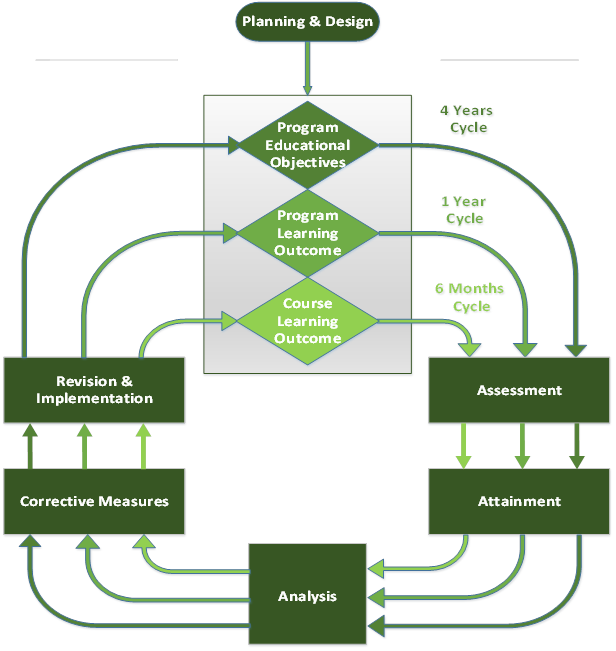
CQI Model

To become the academic leader in software engineering with a professional and technological focus on societal development.
To prepare graduates to have concrete software engineering knowledge, real-world problem-solving skills, excellent leadership qualities, and entrepreneurial abilities for their professional growth and service to society.
PEO1: Apply sound engineering knowledge and skills to design, analyze and investigate a problem for appropriate solutions.
PEO2: Exhibit professionally sound character, having leadership qualities, adaptability in a team, and entrepreneurial skills.
PEO3: Demonstrate devotion through ethical engineering practices and effective communication skills to serve the society.
The mapping of PEOs with the Vision and Mission of UAJ&K is presented below:
| University Vision and Mission Statements | PEO 1 | PEO 2 | PEO 3 | |
|---|---|---|---|---|
| Vision | Transformation to excellence through holistic education. | ✓ | ✓ | ✓ |
| Mission | The University of Azad Jammu & Kashmir is committed to quality education, research, and values-driven mentorship through innovations to serve the society and the changing world. | ✓ | ✓ | ✓ |
The mapping of PEOs with the Vision and Mission of the department is shown below:
| Department Vision and Mission Statements | PEO 1 | PEO 2 | PEO 3 | |
|---|---|---|---|---|
| Vision | To become the academic leader in software engineering with a professional and technological focus on societal development. | ✓ | ✓ | ✓ |
| Mission | To prepare graduates to have concrete software engineering knowledge, real-world problem-solving skills, excellent leadership qualities, and entrepreneurial abilities for their professional growth and service to society. | ✓ | ✓ | ✓ |
PLO 1: Engineering Knowledge — Ability to apply knowledge of mathematics, science, engineering fundamentals, and an engineering specialization to the solution of complex engineering problems.
PLO 2: Problem Analysis — Ability to identify, formulate, research literature, and analyze complex engineering problems using first principles of mathematics, natural sciences, and engineering sciences.
PLO 3: Design / Development of Solutions — Ability to design solutions for complex engineering problems and systems that meet specified needs with appropriate societal, environmental, and safety considerations.
PLO 4: Investigation — Ability to investigate complex engineering problems through literature review, experimental design, data analysis, and synthesis of information to draw valid conclusions.
PLO 5: Modern Tool Usage — Ability to select and apply modern engineering and IT tools for complex engineering tasks, understanding their limitations.
PLO 6: The Engineer and Society — Ability to assess societal, health, safety, legal, and cultural issues and responsibilities relevant to engineering practice.
PLO 7: Environment and Sustainability — Understanding the impact of engineering solutions in societal and environmental contexts and demonstrating knowledge of sustainable development.
PLO 8: Ethics — Apply ethical principles and commit to professional responsibilities and norms of engineering practice.
PLO 9: Individual and Teamwork — Ability to function effectively as an individual and as a team member in multidisciplinary settings.
PLO 10: Communication — Ability to communicate effectively on complex engineering activities with engineering community and society at large through reports, documentation, and presentations.
PLO 11: Project Management — Ability to apply engineering and management principles as a team member or leader to manage projects in multidisciplinary environments.
PLO 12: Lifelong Learning — Ability to recognize the importance of and engage in lifelong learning in the context of innovation and technological development.
The twelve PLOs are appropriately linked to the three PEOs. The mapping is shown below:
| Sr. # | Program Learning Outcomes (PLOs) | PEO 1 | PEO 2 | PEO 3 |
|---|---|---|---|---|
| 1 | Engineering Knowledge | ✓ | ||
| 2 | Problem Analysis | ✓ | ||
| 3 | Design/Development of Solutions | ✓ | ||
| 4 | Investigation | ✓ | ||
| 5 | Modern Tool Usage | ✓ | ||
| 6 | The Engineer and Society | ✓ | ||
| 7 | Environment and Sustainability | ✓ | ||
| 8 | Ethics | ✓ | ||
| 9 | Individual and Teamwork | ✓ | ||
| 10 | Communication | ✓ | ||
| 11 | Project Management | ✓ | ||
| 12 | Lifelong Learning | ✓ |

